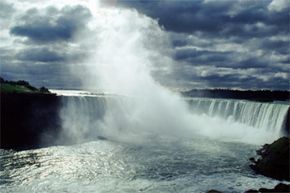Making Electricity
In Michael Faraday's generator, coils of copper wire rotating between the poles of a magnet produce a steady current of electricity. One way to rotate the disk is to crank it by hand, but this isn't a practical way to make electricity. Another option is to attach the shaft of the generator to a turbine and then let some other energy source power the turbine. Falling water is one such energy source, and, in fact, the first major plant ever built took advantage of the enormous kinetic energy delivered by Niagara Falls.
George Westinghouse opened that plant in 1895, but the principles of its operation haven't changed much since then. First, engineers build a dam across a river to create a reservoir of stored water. They place a water intake near the bottom of the dam wall, which allows water to flow from the reservoir and through a narrow channel called a penstock. The turbine -- imagine a huge propeller -- sits at the end of the penstock. The shaft from the turbine goes up into the generator. When the water moves across the turbine, it spins, rotating the shaft and, in turn, rotating the copper coils of the generator. As the copper coils spin within the magnets, electricity is produced. Power lines connected to the generator carry electricity from the power plant to homes and businesses. Westinghouse's Niagara Falls plant was able to transport electricity more than 200 miles (322 kilometers).
Advertisement
Not all power plants rely on falling water. Many take advantage of steam, which acts like a fluid and can therefore transfer energy to a turbine and, ultimately, to a generator. The most popular way to make steam is to heat water by burning coal. It's also possible to use controlled nuclear reactions to turn water into steam. You can read about the various types of power stations in How Hydropower Plants Work, How Wind Power Works and How Nuclear Power Works. Just keep in mind that they all work on the same basic principle of converting mechanical energy -- spinning turbine -- into electrical energy.
Of course, using a generator to make electricity is just the beginning. After you get your electrons moving along, you'll need an electrical circuit to do anything with it. Find out why next.
